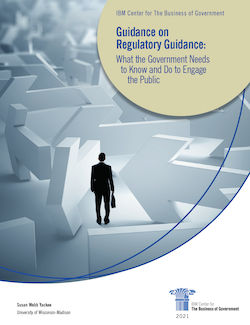
Guidance on Regulatory Guidance: What the Government Needs to Know and Do to Engage the Public

Federal agencies routinely issue guidance documents to announce policy statements and to clarify the meaning of existing statutes and regulations. Over time, guidance documents have become a principal agency policy instrument.
However, agencies have had no uniform process to issue guidance, no common strategy for public engagement, and no archival record of past guidance. Taken together, the current system creates a mismatch between the importance of guidance documents as a modern policy tool of government, and the ability of Americans to understand and participate in the public policymaking processes that govern them.
This report provides a roadmap for the government to improve the creation and management of agency guidance documents by fostering a more citizen-driven process. The report reviews guidance document development at the federal level and compares the current process for developing guidance with the more commonly understood process for promulgating notice and comment regulations The report then highlights findings from an analysis of a past guidance reform effort and a research study of stakeholder involvement during guidance creation at the Food and Drug Administration (FDA).
The recommendations could be enacted by executive order or memoranda, or pursued through congressionally passed legislation. The recommendations are designed to retain the flexibility and timeliness present in the current guidance document development process while simultaneously improving that process. In brief, the report recommends that the government:
- Develop standardized definitions for guidance and major guidance documents.
- Create a centralized repository for current federal government guidance.
- Archive guidance at a semiannual interval.
- Harness technology to alert members of the public to new and rescinded guidance.
- Enact a public commenting process for major guidance, which would occur immediately after a guidance document’s issuance.
The report builds on the Center’s longstanding research on ways to improve public engagement with government across key program, process, and management domains—including the recent essay on “Community-Driven Government— Reimagining Systems in a Pandemic” contained within our report, COVID-19 and its Impact; The Road to Agile Government: Driving Change to Achieve Success; Transforming How Government Operates: Four Methods of Change; and Applying Design Thinking to Public Service Delivery.
We hope that Professor Yackee’s insights, findings, and recommendations help the new administration design and implement strategies for effective issuance of and public engagement with regulatory guidance.



